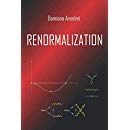Renormalization
In three spacetime dimensions, where no graviton propagates, pure gravity is known to be finite. It is natural to inquire whether finiteness survives the coupling with matter. Standard arguments ensure that there exists a subtraction scheme where no Lorentz-Chern-Simons term is generated by radiative corrections, but are not sufficiently powerful to ensure finiteness. Therefore, it is necessary to perform an explicit (two-loop) computation in a specific model. I consider quantum gravity coupled with Chern-Simons U(1) gauge theory and massless fermions and show that renormalization originates four-fermion divergent vertices at the second loop order. I conclude that quantum gravity coupled with matter, as it stands, is not finite in three spacetime dimensions.
Nucl.Phys. B687 (2004) 143-160 | DOI: 10.1016/j.nuclphysb.2004.03.023
I study some aspects of the renormalization of quantum field theories with infinitely many couplings in arbitrary space-time dimensions. I prove that when the space-time manifold admits a metric of constant curvature the propagator is not affected by terms with higher derivatives. More generally, certain lagrangian terms are not turned on by renormalization, if they are absent at the tree level. This restricts the form of the action of a non-renormalizable theory, and has applications to quantum gravity. The new action contains infinitely many couplings, but not all of the ones that might have been expected. In quantum gravity, the metric of constant curvature is an extremal, but not a minimum, of the complete action. Nonetheless, it appears to be the right perturbative vacuum, at least when the curvature is negative, suggesting that the quantum vacuum has a negative asymptotically constant curvature. The results of this paper give also a set of rules for a more economical use of effective quantum field theories and suggest that it might be possible to give mathematical sense to theories with infinitely many couplings at high energies, to search for physical predictions.
Class.Quant.Grav. 20 (2003) 2355-2378 | DOI: 10.1088/0264-9381/20/11/326
I study some classes of RG flows in three dimensions that are classically conformal and have manifest $g \rightarrow 1/g$ dualities. The RG flow interpolates between known (four-fermion, Wilson-Fischer, $\phi_3^6$) and new interacting fixed points. These models have two remarkable properties: $i$) the RG flow can be integrated for arbitrarily large values of the couplings g at each order of the $1/N$ expansion; $ii$) the duality symmetries are exact at each order of the $1/N$ expansion. I integrate the RG flow explicitly to the order ${\cal O}(1/N)$, write correlators at the leading-log level and study the interpolation between the fixed points. I examine how duality is implemented in the regularized theory and verified in the results of this paper.
Nucl.Phys. B658 (2003) 440 | DOI: 10.1016/S0550-3213(03)00174-3
We go on in the program of investigating the removal of divergences of a generical quantum gauge field theory, in the context of the Batalin-Vilkovisky formalism. We extend to open gauge-algebrae a recently formulated algorithm, based on redefinitions $\delta\lambda$ of the parameters $\lambda$ of the classical Lagrangian and canonical transformations, by generalizing a well-known conjecture on the form of the divergent terms. We also show that it is possible to reach a complete control on the effects of the subtraction algorithm on the space $M_{gf}$ of the gauge-fixing parameters. A principal fiber bundle $E \rightarrow M_{gf}$ with a connection $\omega_1$ is defined, such that the canonical transformations are gauge transformations for $\omega_1$. This provides an intuitive geometrical description of the fact the on shell physical amplitudes cannot depend on $M_{gf}$. A geometrical description of the effect of the subtraction algorithm on the space $M_{ph}$ of the physical parameters lambda is also proposed. At the end, the full subtraction algorithm can be described as a series of diffeomorphisms on $M_{ph}$, orthogonal to $M_{gf}$ (under which the action transforms as a scalar), and gauge transformations on $E$. In this geometrical context, a suitable concept of predictivity is formulated. We give some examples of (unphysical) toy models that satisfy this requirement, though being neither power counting renormalizable, nor finite.
Class.Quant.Grav. 12 (1995) 319-350 | DOI: 10.1088/0264-9381/12/2/005
We consider the problem of removing the divergences in an arbitrary gauge-field theory (possibly nonrenormalizable). We show that this can be achieved by performing, order by order in the loop expansion, a redefinition of some parameters (possibly infinitely many) and a canonical transformation (in the sense of Batalin and Vilkovisky) of fields and BRS sources. Gauge-invariance is turned into a suitable quantum generalization of BRS-invariance. We define quantum observables and study their properties. We apply the result to renormalizable gauge-field theories that are gauge-fixed with a nonrenormalizable gauge-fixing and prove that their predictivity is retained. A corollary is that topological field theories are predictive. Analogies and differences with the formalisms of classical and quantum mechanics are pointed out.
Class.Quant.Grav. 11 (1994) 2181-2204 | DOI: 10.1088/0264-9381/11/9/005
We study a regularization of the Pauli-Villars kind of the one loop gravitational divergences in any dimension. The Pauli-Villars fields are massive particles coupled to gravity in a covariant and nonminimal way, namely one real tensor and one complex vector. The gauge is fixed by means of the unusual gauge-fixing that gives the same effective action as in the context of the background field method. Indeed, with the background field method it is simple to see that the regularization effectively works. On the other hand, we show that in the usual formalism (non background) the regularization cannot work with each gauge-fixing.In particular, it does not work with the usual one. Moreover, we show that, under a suitable choice of the Pauli-Villars coefficients, the terms divergent in the Pauli-Villars masses can be corrected by the Pauli-Villars fields themselves. In dimension four, there is no need to add counterterms quadratic in the curvature tensor to the Einstein action (which would be equivalent to the introduction of new coupling constants). The technique also works when matter is coupled to gravity. We discuss the possible consequences of this approach, in particular the renormalization of Newton’s coupling constant and the appearance of two parameters in the effective action, that seem to have physical implications.
Phys.Rev. D48 (1993) 5751-5763 | DOI: 10.1103/PhysRevD.48.5751

 Quantum Gravity
Quantum Gravity 


